The SilverStone NightJar NJ700 Passive PSU Review: Silent Excellence
by E. Fylladitakis on November 29, 2021 8:00 AM EST- Posted in
- Cases/Cooling/PSUs
- PSUs
- SilverStone
- Passive Cooling

One particularly annoying drawback of nearly all powerful electronics is the noise generated from their required coolers. Although PC components are getting more and more efficient, the general rule still holds: a powerful PC will come with significant cooling requirements.
This typically is not a concern for gamers, as the noise generated by the PC is often overshadowed by the speakers or headphones. For users who want to build a high-performance entertainment center, however, noise can be a significant issue. When a PC is installed in the living room, it needs to be powerful enough for games, but still quiet while playing/streaming media. The same goes for users who combine their professional and gaming needs into one system or, for whatever reason, they require abundant processing power to perform their profession.
One of the major noise sources inside a PC is the power supply unit (PSU). Low-cost PSUs tend to be less efficient – losing a larger portion of their input power to waste heat – and as a result they rely on a strong flow of air rather than heatsink surface area alone in order to dissipate heat, which makes them quite loud when power requirements are high. Thankfully, improvements in PSU efficiency have been driving down the amount of waste heat (and thus noise) over the years – at least for the higher-end models. As a result, what we often find is that the higher quality (higher priced) a PSU is, the quieter it operates.
In today’s review, we are having a look at a PSU from SilverStone that puts that rule to the test: the Nightjar NJ700, a 700 Watt ATX PSU that is so efficient and well-designed so as to require no active air cooling at all. Although passively cooled PSU are as rare as hen’s teeth, we have seen several passively cooled PSUs in the past, including our recent review of SilverStone’s own Nightjar NJ450-SXL. The unique aspect of the Nightjar NJ700 is the high power output of 700 Watts, which requires an amazingly efficient design to be able to cope with the thermal losses without any active cooling.
| Power specifications ( Rated @ 50 °C ) | |||||
| AC INPUT | 100 - 240 VAC, 50 - 60 Hz | ||||
| RAIL | +3.3V | +5V | +12V | +5Vsb | -12V |
| MAX OUTPUT | 20A | 20A | 58A | 2.5A | 0.3A |
| 100W | 696W | 12.5W | 3.6W | ||
| TOTAL | 700W | ||||
Packaging and Bundle
We received the SilverStone NJ700 in an aesthetically simple but practical cardboard box. The artwork is simplistic, with a blue/gold color theme and based around a picture of the PSU itself. On the other hand, the box is sizable and with very thick exterior walls, providing ample shipping protection.
SilverStone usually goes with the bare minimum number of bundled items, but the NJ700 seems to be an exception. Inside the box, we find the mounting screws, the required AC power cable, a thorough manual, numerous cable ties, and five high-quality black/white cable straps.
The SilverStone Nightjar NJ700 is a fully modular PSU and every cable, including the 24-pin ATX cable, can be detached. With the exception of the 24-pin ATX cable, the rest of the cables are ribbon-like, “flat” type. The main 24-pin ATX cable is made of all-black wires too but they are bundled and held inside a black nylon sleeve.
| SilverStone Nightjar NJ700 | ||
| Connector type | Hardwired | Modular |
| ATX 24 Pin | - | 1 |
| EPS 4+4 Pin | - | 1 |
| EPS 8 Pin | - | - |
| PCI-E 6+2 Pin | - | 4 |
| PCI-E 8 Pin | - | - |
| SATA | - | 12 |
| Molex | - | 6 |
| Floppy | - | 1 |
The SilverStone Nightjar NJ700 PSU
External Appearance
The SilverStone Nightjar NJ700 definitely is an irregular design, with all surfaces except its bottom perforated to allow for the maximum possible passive airflow. The perforation pattern alone is enough to hint the OEM behind this PSU’s creation to a seasoned expert.
Its chassis is dimensionally close to that of an ATX unit but the NJ700 is 170 mm long, making it a bit longer than what the ATX standard dictates. Still, there should not be any clearance issues with any but the most restrictive of PC cases. Due to its thermal design, however, we would not recommend installing it inside a case with a tight PSU cover because it would essentially block any heat transfer from the unit. The NJ700 is designed so as to be installed with the vents facing upwards, letting the hot air rise and ultimately exit the case via other fans or vents.
In order to leave the heatsinks unobstructed, the designer moved the sticker with the unit’s electrical specifications and certifications to the bottom side of the unit. Even there, the sticker was limited to less than half the surface area, as small vents have been placed under critical components.
At the rear side of the PSU, we find the typical on/off switch and the AC cable receptacle. The interesting thing here is that SilverStone’s engineers placed two mounting hole patterns, allowing the mounting of the PSU to face upwards or downwards. Depending on the case that the PSU will be installed in, the user has to make an educated guess in order to ascertain the optimal orientation for effective passive air cooling. The front side hosts the connectors for the modular cables, all of which are black but are keyed and it is not possible to mix-up the connectors while attaching the cables. A basic legend is sprayed directly on the PSU’s chassis.
Internal Design
With no fan to talk about inside the SilverStone NJ700, we jump right away to the OEM of the platform, who is none other than SeaSonic. As we mentioned above, this is obvious to an experienced PC builder, as the external design of the PSU is, with the exception of the company’s logos, practically identical to that of the SeaSonic Prime Fanless. SilverStone usually employs Enhance for their fanless PSUs but, apparently, Enhance does not yet have a platform that can deliver this high a power output without any active cooling.
As expected from SeaSonic and for the nature of this particular design, the platform that the NJ700 is based upon is pretty much the best it could possibly be without employing cutting-edge digital electronics. That their engineers managed to squeeze 80Plus Titanium efficiency levels out of an analog design is quite a feat on its own. SeaSonic probably sticks with such designs due to their extremely high reliability and proven track record from decades of use.
The insides of the SilverStone Nightjar NJ700 do not look much different than any other high quality 700W PSU. Even the heatsinks, though sizable, are not as substantial as one would expect from a passively cooled unit. Only the heatsink placed directly on the main transformer stands out compared to typical ATX products.
A generous filtering stage begins at the back of the AC receptacle, under a shield, with six Y capacitors, three X capacitors, and two filtering coils. There are two powerful rectifying bridges, with a sizable heatsink sandwiched in between them. There are two APFC capacitors, both made by Nippon Chemi-Con and rated at 400v/470μF each.
The primary side of the PSU is a standard full-bridge configuration with an LLC resonant converter. On the secondary side, four MOSFETs generate a single 12V line, with additional DC-DC converters present to generate the 5V and 3.3V lines from that. The difference is that both the four inverting transistors on the primary side and the four converting MOSFETs on the secondary side are top-tier products with extremely low drain-source resistance and gate charge, making them remarkably efficient.
Most of the secondary capacitors in the SilverStone NJ700 are polymer products made by FPCAP. A lot of them are placed on the secondary PCB that holds the connectors for the power cables for the final filtering of the DC power lines. Nevertheless, there are a few electrolytic capacitors present, one made by Rubycon and the rest by Nippon Chemi-Con, making the Nightjar NJ700 an all-Japanese affair.


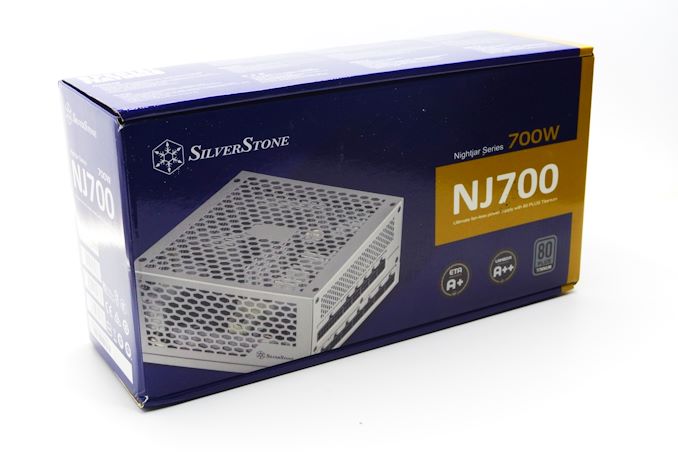
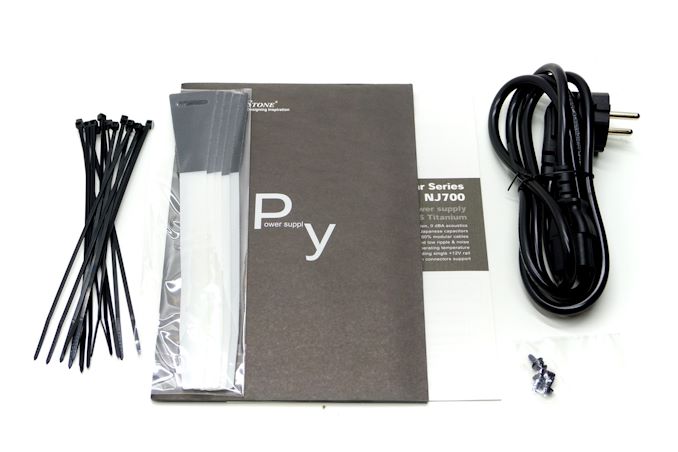

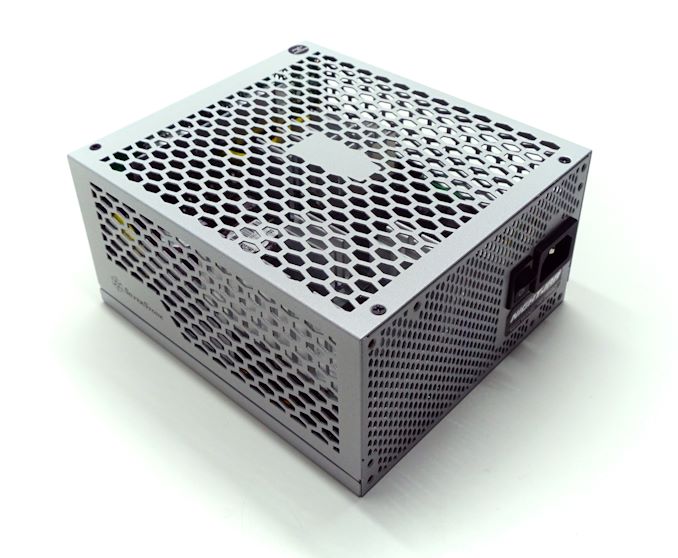
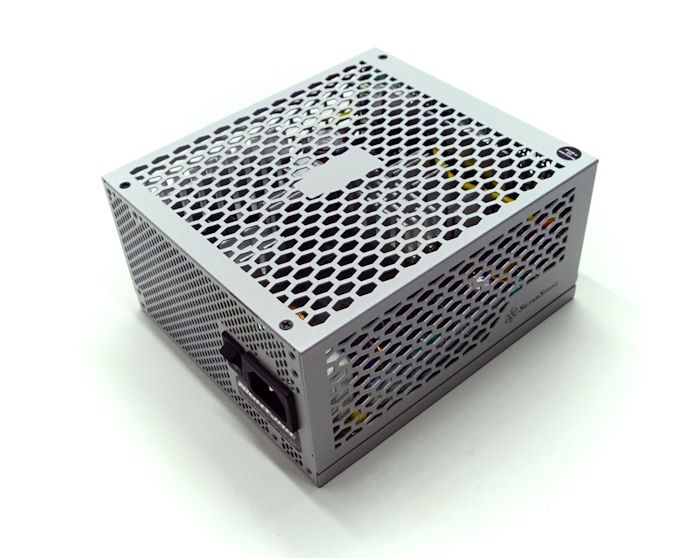
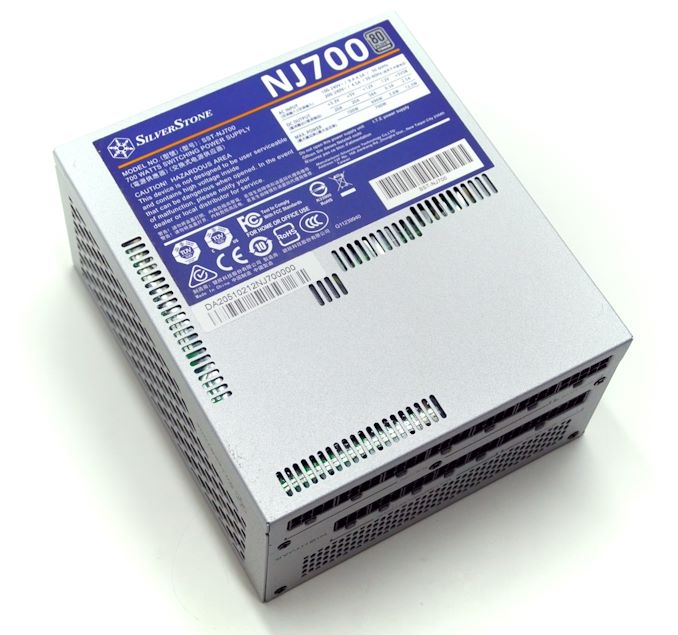
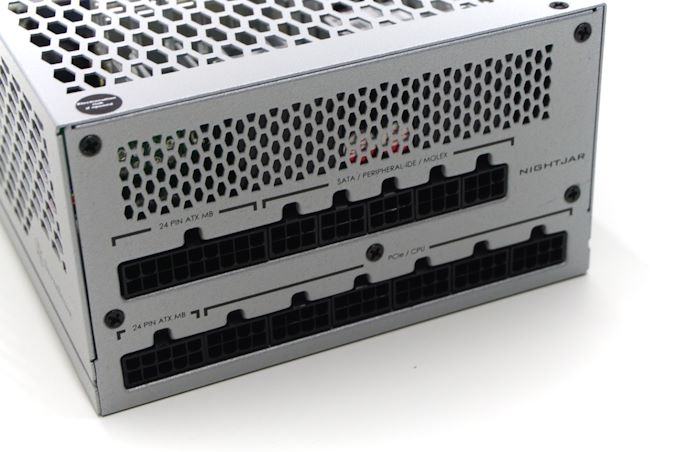
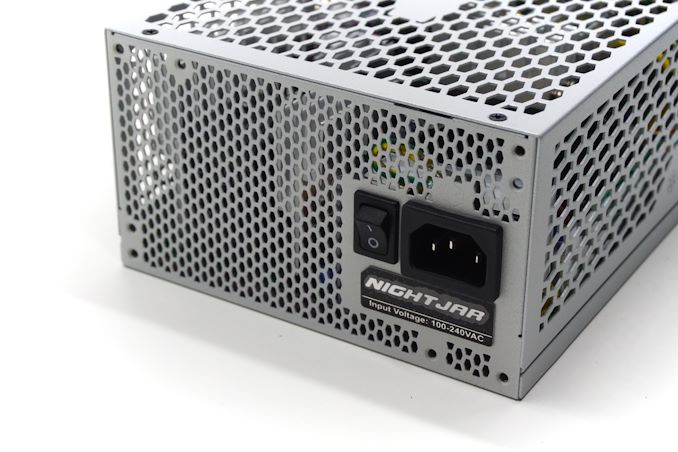
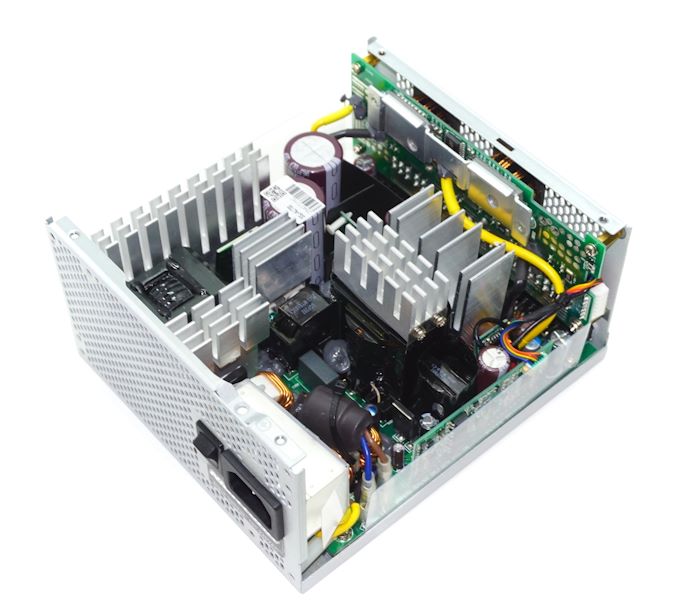
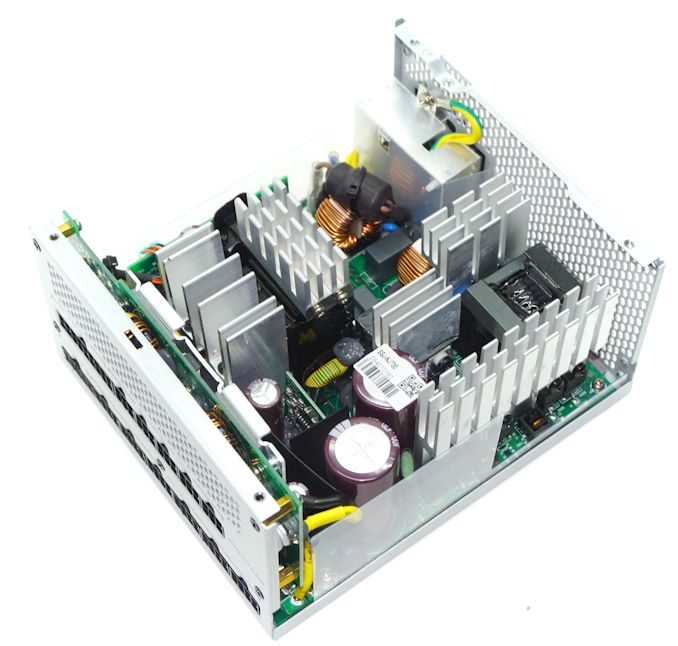
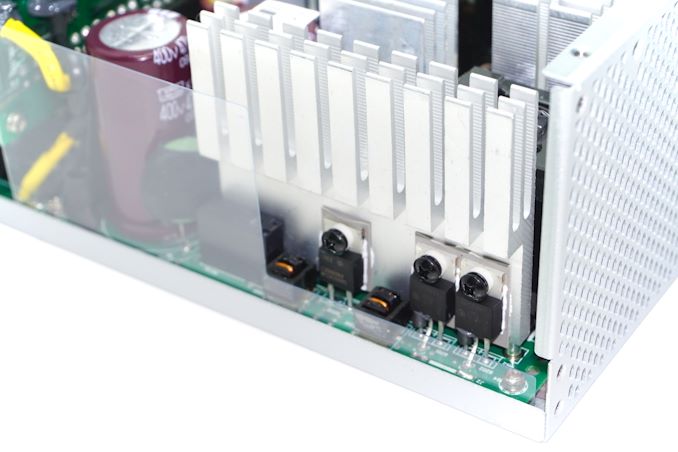
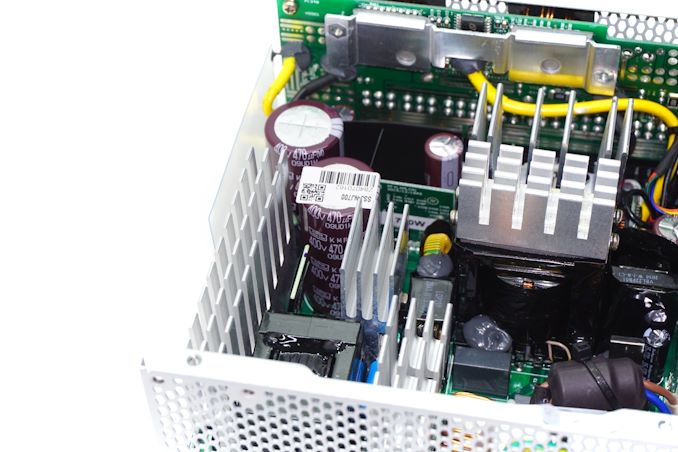








46 Comments
View All Comments
Rοb - Tuesday, November 30, 2021 - link
The only reason I see is that it's silver colored and says SilverStone on it, which might fit better with a SilverStone case build.SeaSonic's closest choices are black and white: https://seasonic.com/prime-fanless-tx or https://seasonic.com/prime-snow-silent
The choice seems fairly black and white to me too, unless you want SeaSonic's black and red 850W model; with advanced fan control - no harm in having a slow fan in the power supply to create a draft in a clearly useful direction, rather than relying on faster case fan speeds to guarantee that the flow through the power supply is above the minimum requirements.
tonyou - Monday, January 3, 2022 - link
Looks like the tuning we did to improve standby efficiency and reduced electrical noise/whine helped to make it perform a little better overall according to latest test result by TechPowerUp:https://www.techpowerup.com/review/seasonic-prime-...
Somewhat surprised Seasonic didn't bother to implement the changes made to our Nightjar NJ700 into their own retail version.
Arbie - Monday, November 29, 2021 - link
Quieter is better, and a passive design admirable - but the PSU adds little to the overall noise of my system. The fact that it can even be managed passively should tell you something. Case fans and CPU / GPU cooling contribute much more and I think always will.Oxford Guy - Monday, November 29, 2021 - link
‘the PSU adds little to the overall noise of my system’That’s one data point and we don’t know about all the variables. Your system could use Delta industrial fans at full tilt to cool its components or a recent Atom motherboard.
CharonPDX - Monday, November 29, 2021 - link
Impressive. I have a media center computer that has plenty of airflow around it that I'm trying to quiet down. It uses ~250-300W at "full power", I've always been using a 350-450W PSU in it, but this thing being most efficient at right around that power range seems very tempting.Oxford Guy - Monday, November 29, 2021 - link
‘This typically is not a concern for gamers, as the noise generated by the PC is often overshadowed by the speakers or headphones.’Strongly disagree.
I’ve read this headphones claim many times but even the kind of noise-blockers sold in hardware stores let some noise through.
A game that is designed to use subtle environmental sounds to create ambiance is generally going to be undermined by fan noise, especially if it uses PWM.
Trying to bury noise with speakers makes even less sense.
One of the things I especially disliked about the CD-ROM era of consoles was all the noise the machine outputted. As someone who started with fanless cartridge-based gaming the idea of it not being important to have a quiet unit — even with bleep/bloop arcade stuff, is one experience doesn’t support.
Young people are getting hearing damage from using headphones in noisy environments. Blasting music can mask noise but there’s a price to pay.
Wrs - Tuesday, November 30, 2021 - link
Active noise cancelation fixes this, though there are times when being environmentally unaware is a liability.Practically, I just find it quite hard to build a 700w system under 25db. Even water pumps and most radiator fans break that if loaded. Most those top PSUs with fans sit around low 20s dB at full load, and the noise is low frequency so very easy for ANC to deal with.
Oxford Guy - Thursday, December 2, 2021 - link
Citation please for the noise cancellation claim. If that’s true then the LRAD can be easily defeated by people wearing noise-cancelling headphones.I also think the claim that the total system noise is determined solely by whatever component produces the most noise is false. One 25 decibel fan is quiet. Five of them is louder. So, PSU noise can add to the sum.
Wrs - Saturday, December 4, 2021 - link
Which claim? The low frequency knack is common knowledge and I figure anyone who's tried ANC would discover it. Wiki ANC and search for "active vs. passive."I use ANC and barely hear the drone of 1500 rpm fans when my fully air cooled open case rig is loaded to >700 watts at the wall. Forget about hearing anything <1000 rpm with the -30 dB attenuation typical of low frequency ANC.
We're talking quiet office level sound of course. Idk if ANC can even be designed against an LRAD, where it's not even so much hearing damage as tissue injury from shock and cavitation.
Oxford Guy - Friday, December 10, 2021 - link
If noise cancellation is as good as you claim then it’s going to save a lot of people’s hearing. A recent journal article I read about subway commuters developing hearing loss from too much ambient noise didn’t mention such headphones. Curious that the pro researchers would miss something if it’s that effective. The only time I’ve seem headphone use discussed in an ambient noise hearing loss context is in terms of headphones making the problem worse via people simply turning up the volume.The pair of ‘noise-blocking’ headphones I tried had terrible hiss. PC Mag claims that that’s only seen in low-quality models but those were expensive Beats.
As someone who gets serious tinnitus flareups from computer fans (and possibly coil whine) I am certainly hopeful that this tech is the panacea you say it is.